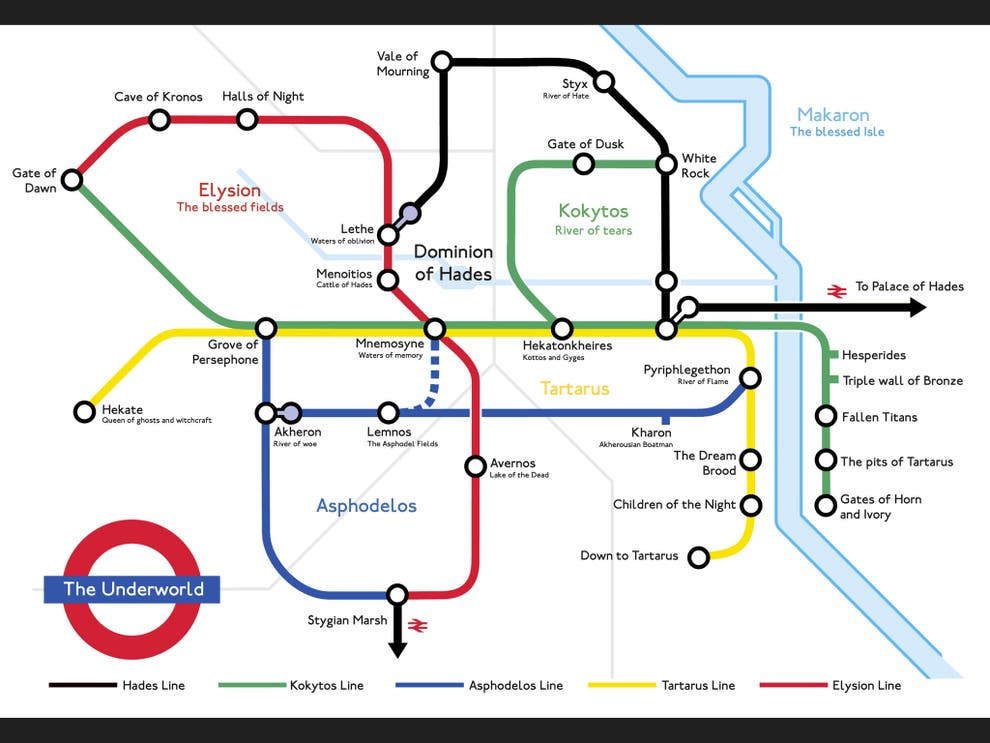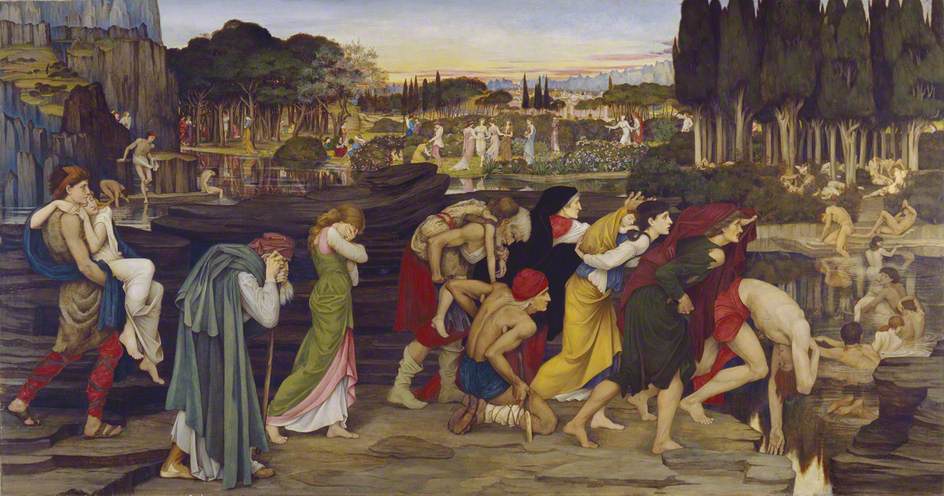I have been exploring the Greek underworld - not literally, obviously - but because The Penelopiad by Margaret Atwood, the play I am directing and co-producing, is partially set there.The underworld
itself - sometimes known as Hades,
after its patron god - is described as being either at the outer bounds of the
ocean or beneath the depths or ends of the earth.
It is considered the dark counterpart to the brightness of Mount Olympus with the kingdom of the dead corresponding
to the kingdom of the gods. The Underworld is a realm invisible to the living, made solely for the dead.
 |
Landscape with Charon crossing the Styx by Joachim Patinir
|
The Greeks had a definite belief that
there was a journey to the afterlife or another world. They believed that death
was not a complete end to life or human existence.
In the Greek underworld, the souls of the dead still existed, but they are insubstantial, and flitted around the underworld with no sense of purpose. The Greeks accepted the existence of the soul after death, but saw this afterlife as meaningless. In the underworld, the
identity of a dead person still existed, but it had no strength or true influence. The dead within the Homeric underworld lack menos,or strength, and therefore they cannot influence those on earth. They also lack phrenes, or wit, and are heedless of what goes on around them and on the earth above them. Their lives in the underworld were very neutral, so all social statuses and political positions were eliminated and no one was able to use their previous lives to their advantage in the underworld.
Generally
speaking, the Greek Underworld can be thought of as being made up of three
different regions; Tartarus, the Asphodel Meadows and Elysium.
 |
| An alternative view of the London Underground tube map by the Iris Project |
While Tartarus is not considered to be directly a part of
the underworld, it is described as being as far beneath the underworld as the
earth is beneath the sky. It was thought to be the deepest region of the
Underworld, ad a place where it would take an anvil nine days to reach if
allowed to fall from the rest of the Underworld. It is so dark that the “night
is poured around it in three rows like a collar round the neck, while above it
grows the roots of the earth and of the unharvested sea.” – Robert Garland, The Greek Way of Death
Tartarus is the region of the Underworld
normally associated with hell, and was the area where imprisonment and
punishment was undertaken; as such it was the normal location of the imprisoned
Titans, Tantalus, Ixion and Sisyphus. Zeus cast the Titans along with his father Cronus into Tartarus after
defeating them. Homer wrote that Cronus then became the king of Tartarus. While Odysseus does not see the Titans himself, he
mentions some of the people within the underworld who are experiencing
punishment for their sins.
 |
Aneas and Sibyl in the Underworld by Jan Brueghel the Younger
|
The Asphodel Meadows was a place for ordinary or indifferent
souls who did not commit any significant crimes, but who also did not achieve
any greatness or recognition that would warrant them being admitted to
the Elysian Fields. It was where mortals who did not belong
anywhere else in the underworld were sent. It was where the majority of the
deceased would end up, for it was the region of indifference. Having drunk
from the River Lethe the deceased located here would forget their previous
lives, but would spend eternity in a greyness of mindlessness.
While
in the underworld, the dead passed the time through simple pastimes such as
playing games, as shown from objects found in tombs such as dice and
game-boards. Grave gifts such as clothing, jewellery, and food were left
by the living for use in the underworld as well, since many viewed these gifts
to carry over into the underworld. There was not a general consensus
as to whether the dead were able to consume food or not. Homer depicted the
dead as unable to eat or drink unless they had been summoned; however, some
reliefs portray the underworld as having many elaborate feasts. While not
completely clear, it is implied that the dead could still have sexual intimacy
with another, although no children were produced. The Greeks also showed belief
in the possibility of marriage in the underworld, which in a sense describes
the Greek underworld having no difference than from their current life.
 |
Fields of Asphodel by Brian Doers
|
Elysium, or the Elysian Fields, was a place for
the especially distinguished. It was ruled over by Rhadamanthus, and the souls that dwelled there had an easy
afterlife and would spend an eternity of pleasure free from work and strife. Usually, those who had proximity to the
gods were granted admission, rather than those who were especially righteous or
had ethical merit, however, later on, those who were pure and righteous were
considered to reside in Elysium. Most accepted to Elysium were demigods or
heroes. Heroes such as Cadmus, Peleus, and Achilles also were transported here after their
deaths. Normal people who lived righteous and virtuous lives could also gain
entrance such as Socrates who proved his worth sufficiently through
philosophy. It is the region of the Underworld where mortals were supposed to
aspire to and the most closely associated with paradise.
 |
| The Waters of Lethe by the Plains of Elysium by John Rodham Spencer-Stanhope |
The idea of progress did not exist in
the Greek underworld – at the moment of death, the psyche was frozen,
in experience and appearance. The souls in the underworld did not age or really
change in any sense. They did not lead any sort of active life in the
underworld – they were exactly the same as they were in life. Therefore,
those who had died in battle were eternally blood-spattered in the underworld
and those who had died peacefully were able to remain that way.
Overall, the Greek dead were considered to be
irritable and unpleasant, but not dangerous or malevolent. They grew angry if
they felt a hostile presence near their graves and drink
offerings were given in order to appease them so as not to anger the
dead. Mostly, blood offerings were given, because they needed the essence
of life to become communicative and conscious again. This is shown in
Homer's Odyssey, where Odysseus had to give blood in order for
the souls to interact with him.
Hades
itself was free from the concept of time. The dead are aware of both the past
and the future, and in poems describing Greek heroes, the dead helped move the
plot of the story by prophesying and telling truths unknown to the
hero. The only way for humans to communicate with the dead was to suspend
time and their normal life to reach Hades, the place beyond immediate
perception and human time.
It sounds as though social strata was rigidly imposed even back then and even in death.





No comments:
Post a Comment